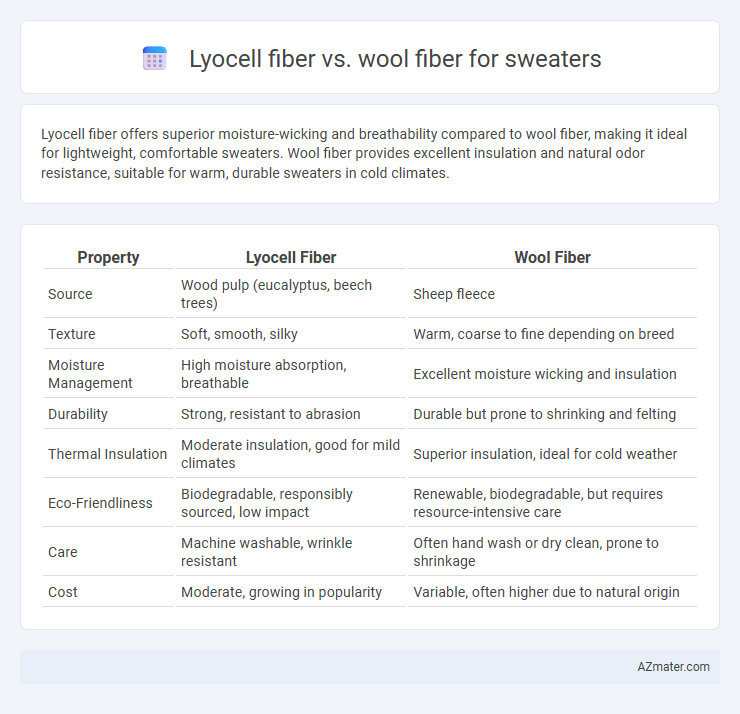Lyocell fiber offers superior moisture-wicking and breathability compared to wool fiber, making it ideal for lightweight, comfortable sweaters. Wool fiber provides excellent insulation and natural odor resistance, suitable for warm, durable sweaters in cold climates.
Table of Comparison
| Property | Lyocell Fiber | Wool Fiber |
|---|---|---|
| Source | Wood pulp (eucalyptus, beech trees) | Sheep fleece |
| Texture | Soft, smooth, silky | Warm, coarse to fine depending on breed |
| Moisture Management | High moisture absorption, breathable | Excellent moisture wicking and insulation |
| Durability | Strong, resistant to abrasion | Durable but prone to shrinking and felting |
| Thermal Insulation | Moderate insulation, good for mild climates | Superior insulation, ideal for cold weather |
| Eco-Friendliness | Biodegradable, responsibly sourced, low impact | Renewable, biodegradable, but requires resource-intensive care |
| Care | Machine washable, wrinkle resistant | Often hand wash or dry clean, prone to shrinkage |
| Cost | Moderate, growing in popularity | Variable, often higher due to natural origin |
Introduction to Lyocell and Wool Fibers
Lyocell fiber, derived from sustainable wood pulp using a closed-loop production process, offers exceptional moisture-wicking and breathability, making it ideal for lightweight sweaters. Wool fiber, sourced from sheep, provides natural insulation, excellent warmth, and durability, suitable for colder climates and heavy sweaters. Comparing Lyocell and Wool fibers highlights differences in environmental impact, comfort, and thermal properties for sweater applications.
Fiber Origins and Production Processes
Lyocell fiber is derived from sustainably sourced wood pulp, primarily from eucalyptus, beech, and spruce trees, using a closed-loop solvent spinning process that recycles water and solvents to minimize environmental impact. Wool fiber comes from the fleece of sheep, harvested through shearing, followed by cleaning and carding to prepare the natural protein fibers for spinning into yarn. The production of Lyocell focuses on eco-friendly practices with a semi-synthetic origin, while wool's production is natural, reliant on animal husbandry and traditional textile methods.
Environmental Impact Comparison
Lyocell fiber offers a significantly lower environmental impact than wool, as it is produced from sustainably sourced eucalyptus trees through a closed-loop process that recycles water and solvents, reducing chemical waste and energy use. Wool production involves higher greenhouse gas emissions due to methane release from sheep and requires extensive land and water resources, contributing to soil degradation and biodiversity loss. Lyocell's biodegradability and lower carbon footprint make it a more eco-friendly choice for sustainable sweater manufacturing.
Comfort and Breathability
Lyocell fiber offers superior breathability and moisture-wicking properties, making it ideal for sweaters that maintain comfort in various temperatures. Wool fiber provides excellent insulation and natural temperature regulation, but can sometimes cause itchiness for sensitive skin. Combining Lyocell's softness with wool's warmth delivers a balanced sweater fabric that enhances overall comfort and breathability.
Moisture Management and Absorbency
Lyocell fiber exhibits superior moisture management by effectively wicking away perspiration and drying quickly, making it ideal for sweaters worn in active or warm environments. Wool fiber, while also moisture-absorbent, retains water up to 30% of its weight without feeling wet, providing insulation and breathability but slower drying times. Choosing Lyocell ensures enhanced moisture control and comfort, whereas wool offers natural temperature regulation with moderate absorbency.
Durability and Longevity
Lyocell fiber offers high tensile strength and resistance to wear, making it durable for everyday sweater use, while wool fiber provides natural elasticity and resilience that help maintain shape over time. Wool's moisture-wicking and insulating properties contribute to its longevity by preventing fiber deterioration caused by sweat, whereas Lyocell's smooth surface resists pilling and fiber breakdown. Both fibers exhibit strong durability, but wool's natural adaptations often give it an edge in lifespan for sweaters worn in varied climates.
Texture and Feel Against Skin
Lyocell fiber offers a smooth, silky texture that feels soft and cool against the skin, making it ideal for sensitive skin or warm climates. Wool fiber provides a natural, slightly coarse texture with excellent warmth and breathability, creating a cozy and insulating layer especially suited for cold weather. While Lyocell ensures lightweight comfort and moisture-wicking properties, wool delivers a plush, resilient feel with natural elasticity and temperature regulation.
Care and Maintenance Requirements
Lyocell fiber sweaters require gentle washing with cold water and mild detergent to maintain softness and prevent shrinkage, with air drying recommended to avoid distortion. Wool fiber sweaters demand careful hand washing or dry cleaning, using specialized wool detergents to preserve fiber integrity and prevent felting or shrinkage, while flat drying maintains garment shape. Both fibers benefit from proper storage in a cool, dry place to avoid moth damage and maintain longevity.
Cost and Market Availability
Lyocell fiber offers a more affordable price point compared to wool fiber, making it a cost-effective option for sweater production. Wool fiber, derived primarily from sheep, tends to have higher manufacturing costs due to animal husbandry and processing requirements. Market availability for Lyocell is expanding rapidly thanks to its sustainable production, while wool remains widely available but sometimes limited by regional sourcing and seasonal constraints.
Choosing the Suitable Fiber for Sweaters
Lyocell fiber offers excellent moisture-wicking and breathability, making it ideal for lightweight, breathable sweaters that stay dry and comfortable in warmer conditions. Wool fiber provides superior insulation and natural elasticity, perfect for warm, durable sweaters suited to cold weather. Selecting between Lyocell and Wool for sweaters depends on climate needs: prioritize Wool for warmth and Lyocell for softness and moisture management.

Infographic: Lyocell fiber vs Wool fiber for Sweater
 azmater.com
azmater.com